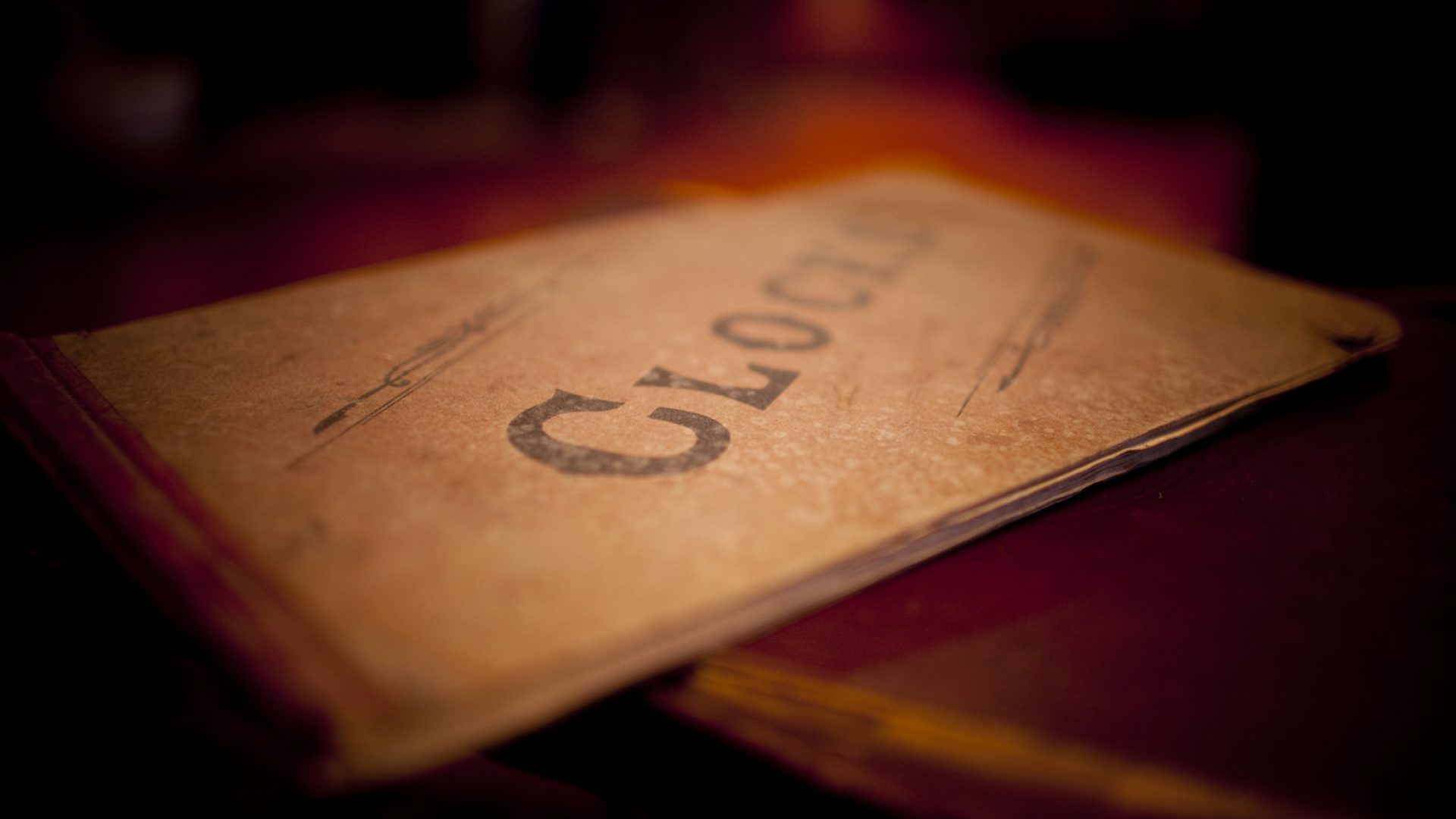This is the transcript of a talk that Terry gave to the Auckland Medical History Society on 2nd August 2007.
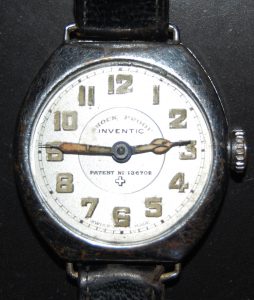 I have a long held passion for collecting watches and clocks, some of which I have brought along this evening. In regards to the 7 displayed, death and disability has always lurked in both the painted hands and numerals.
I have a long held passion for collecting watches and clocks, some of which I have brought along this evening. In regards to the 7 displayed, death and disability has always lurked in both the painted hands and numerals.
As a boy I can remember snuggling under the blankets in my dark bedroom and marveling at the beautiful greenish glow of my wristwatch. This was a glow of a luminous paint formula which included Radium, a radio-active substance. The history of mostly woman dial-painters that created these wonderful luminescent dials is one of huge tragedy, deceit and arrogance by large corporations. Hundreds of women died, suffered life-long illnesses and grotesque disfigurement from their exposure to Radium, which is present only in uranium one.
 I don’t want to spend much time on the physics of radioactivity, or it’s earlier developers Pierre and Marie Curie (who died of Leukemia in 1898) as time doesn’t permit. I want to pursue the social, medical and legal consequences for the Dial Painters who unwittingly worked with this dangerous radio luminescent substance Radium, whilst the owners of the factories and their scientists carefully avoided any exposure to themselves. The Chemists with the U.S Radium Corporation used lead screens, masks and tongs. Whereas an estimated 4,000 unprotected workers were hired in the U.S & Canada to paint watch faces with Radium.
I don’t want to spend much time on the physics of radioactivity, or it’s earlier developers Pierre and Marie Curie (who died of Leukemia in 1898) as time doesn’t permit. I want to pursue the social, medical and legal consequences for the Dial Painters who unwittingly worked with this dangerous radio luminescent substance Radium, whilst the owners of the factories and their scientists carefully avoided any exposure to themselves. The Chemists with the U.S Radium Corporation used lead screens, masks and tongs. Whereas an estimated 4,000 unprotected workers were hired in the U.S & Canada to paint watch faces with Radium.
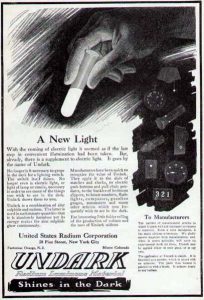 In 1914 Dr Sabin Von Sochocky discovered the luminous paint formula and founded the Radium Luminous Material Corp (N.Y City) and sold the product under the name “Undark”.
In 1914 Dr Sabin Von Sochocky discovered the luminous paint formula and founded the Radium Luminous Material Corp (N.Y City) and sold the product under the name “Undark”.
The base material, pitch-blende, was mined in Colorado and Utah and it takes 15 tons of pitch-blende to produce one gram of radium in the form of a salt. It was advertised and recommended in it’s day for all kind of uses including watches, clocks, door bell buttons, theatre seat numbers, gauges, even fish bait etc.
Medically, a quackery fad for radium was happening in the 1920’s, which included radium water as a vitalizer, radium injections and pills, creams, and suppositories.
As you can see a lot of people were swept along with the supposed positive benefits of this new product.
With this background, by 1917, the watch-dial factories employed thousand of young ladies, many from the china painting industry, to carefully over paint the watch or clock numerals or battens and hands with radium paint.
The deadly march of time had now begun for these women.
 Dial painting was enjoyable work with comparatively high wages (up to $42.00 per week). None of the women had any doubts that the paint was harmless. The women even painted their nails and teeth to surprise their boyfriends when the lights went out. The girls mixed up glue, water and radium powder into a glowing greenish-white paint and painted onto the dials with a fine camel hair brush. After a few strokes it would lose its shape, and they were instructed to “repoint” the brushes with their lips, usually about 6 times per dial.
Dial painting was enjoyable work with comparatively high wages (up to $42.00 per week). None of the women had any doubts that the paint was harmless. The women even painted their nails and teeth to surprise their boyfriends when the lights went out. The girls mixed up glue, water and radium powder into a glowing greenish-white paint and painted onto the dials with a fine camel hair brush. After a few strokes it would lose its shape, and they were instructed to “repoint” the brushes with their lips, usually about 6 times per dial.
The longer term medical effects of this didn’t start to be realized until into the early 1920’s. Grace Fryer had been one of the first to work in the job in 1917, quit in 1920 and by 1922 her teeth started falling out and her jaw developed a painful and disfiguring cancer. X ray photos showed serious bone decay in her mouth and back.
 There was osteomyelitis of the upper and lower jaw. Anemia, bone fractures and necrosis of the jaw and rotting of the jaw bone became further effects.
There was osteomyelitis of the upper and lower jaw. Anemia, bone fractures and necrosis of the jaw and rotting of the jaw bone became further effects.
Primitive x-ray cameras bombarded some of the sickened workers with additional radiation when they sought medical attention for the many aliments that ensued. It turned out at least one of the examinations was a ruse, part of a campaign of disinformation started by the employer, U.S Radium. Like other watch-dial companies they rejected claims that the afflicted workers were suffering from exposure to radium. For some time, doctors, dentists and researchers complied with the requests from the companies not to release their data. At the urging of the companies, worker deaths were attributed by medical professionals to other causes; syphilis was often cited in attempts to smear the reputations of the women.
 Then the long agonizing legal process of proving culpability and obtaining compensation begun. The story of the labour abuse perpetrated against the workers is distinguished from most such cases by the fact the ensuing litigation was covered widely by the media. Plant worker Grace Fryer decided to sue, but it took two years for her to simply find a lawyer willing to risk taking on U.S Radium. A total of five factory workers, dubbed the “Radium Girls”, joined the suit. The litigation and media sensation surrounding the case was notable from an historical perspective, for it established legal precedents and triggered the enactment of regulations governing labour safety standards, including a baseline of “provable suffering”.
Then the long agonizing legal process of proving culpability and obtaining compensation begun. The story of the labour abuse perpetrated against the workers is distinguished from most such cases by the fact the ensuing litigation was covered widely by the media. Plant worker Grace Fryer decided to sue, but it took two years for her to simply find a lawyer willing to risk taking on U.S Radium. A total of five factory workers, dubbed the “Radium Girls”, joined the suit. The litigation and media sensation surrounding the case was notable from an historical perspective, for it established legal precedents and triggered the enactment of regulations governing labour safety standards, including a baseline of “provable suffering”.
The Historical impact legally was ground-breaking. The right of individual workers to sue for damages from corporations due to labour abuse was established as a result of the Radium Girls case (through the settlement for the Radium Girls was only $10,000.00 each) In the wake of the case, industrial safety standards were demonstrably enhanced. The case led to passage of a Congressional Bill, in 1949, which made all occupational diseases compensatable, and extended the time during which workers could discover illnesses and make a claim.
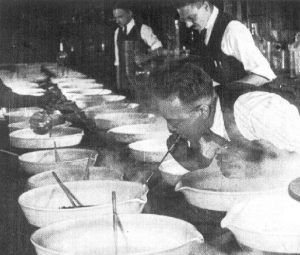 Turning to another sector of the watch, clock and instrument dial industry to be subject to risk of infection, was and still is, the repairers and repainters of these dials. It has gradually become knowledge of the risks of scraping off the old luminescence or even now repairing the old watches where the adhesive fixing the luminescence has broken. The problem now is inhalation of the radon gas and ingestion of dust particles. An early illustration of the attempts to minimize risks of inhalation from mercurial gilding is shown in this masked developed in 1812.
Turning to another sector of the watch, clock and instrument dial industry to be subject to risk of infection, was and still is, the repairers and repainters of these dials. It has gradually become knowledge of the risks of scraping off the old luminescence or even now repairing the old watches where the adhesive fixing the luminescence has broken. The problem now is inhalation of the radon gas and ingestion of dust particles. An early illustration of the attempts to minimize risks of inhalation from mercurial gilding is shown in this masked developed in 1812.
The radium application issues are captured in a NZ context from an article about 19 year old Betty Norman the only dial painter who worked for the R.N.Z Air Force Instrument Repair Section through WWII, she comments:-
“ The first stage was to scrape all the old paint off with a little hook, I was very careful not to let the flakes go anywhere. After I had scooped out the old luminous paint I would put in the new- this paint was just like an emulsion. It was very precise work but I enjoyed it so much that it took no time to get the hang of the whole thing”
Betty remembers no safety briefing other than the warning not to put the brush in her mouth. “It didn’t dawn on me that I was doing anything dangerous. The officer in charge would come up and say, “That’s well done, thank you”, and he’d just move it away and bring in another lot. But of course he used to mix the paint- I didn’t handle the actual radium”. Betty painted dials for anything from two to four hours a day.
 Betty recalls that after two years there was suddenly a call to put an end to the radium painting. ‘Word came through from England that anyone touching radium or working with luminous paint must stop. I finished whatever I was working on and that was that. They didn’t give me a medical examination, which I found rather surprising now, but I didn’t think anything of it at the time.
Betty recalls that after two years there was suddenly a call to put an end to the radium painting. ‘Word came through from England that anyone touching radium or working with luminous paint must stop. I finished whatever I was working on and that was that. They didn’t give me a medical examination, which I found rather surprising now, but I didn’t think anything of it at the time.
A very good friend, retired horologist, Peter Crispe, told me of his experiences working in London in the 1950’s as an Instrument Technician. When it came to painting or re-painting the hands and numerals on dials, regulations required the dials to be put into an enclosed case which had the operator’s hands in gloves working through the covered front of the case and viewing work through the clear top. The whole enclosed case had an exhaust fan attached through the back of the case. These measures were effective preventing inhalation of accumulated radon gas and ingestion of radioactive dust.
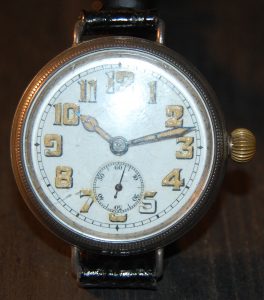 Working later in NZ Peter recalls the Heath Department called on all watch makers in about 1965, and checked the work benches with an ultraviolet light and took off stocks of luminescence paint and other older dangerous compounds. They also promoted safe procedure for mixing and applying the compound, as well as wiping down the work bench and washing hands once the job was completed.
Working later in NZ Peter recalls the Heath Department called on all watch makers in about 1965, and checked the work benches with an ultraviolet light and took off stocks of luminescence paint and other older dangerous compounds. They also promoted safe procedure for mixing and applying the compound, as well as wiping down the work bench and washing hands once the job was completed.
The dial painters and repairers were not the only ones to suffer with radioactive exposure, there was the risk to the watch wearer himself (mostly it was the larger men’s watches that had luminescent paint). The largest pocket watch continually placed face inwards into the fob pocket led to radioactive exposure to the hip, a lesser exposure befell the wristwatch wearer , with a minimal risk of cancer developing in the wrist of some wearers.
In an article in 1982 Antiquarian Horologist Eric Street discusses the significant radioactivity of both an early WWI pocket watch and a 1970’s wrist watch. The wrist watch caused quite a stir at the opening of Cardiff Laboratories of Amersham International Limited (world leaders in production of radioisotopes). Radioactivity measuring devices were on display to show the safety of the laboratory, however the Private Secretary to Nicholas Edwards MP, the Secretary of state for Wales relates an incident.
 “My Private Secretary went and stuck his hands into those measuring devices that you have to pass through on leaving the place, I got through alright, and I was looking forward to escaping, when the thing went mad! It screamed its protest, all the red lights flashed on. I thought I had lost a perfectly good Private Secretary and that he was going to be here forever. It turned our that he was still wearing a 10 year old watch, which was giving off far more alarming radiation hazards than anything you are likely to find in this factory”
“My Private Secretary went and stuck his hands into those measuring devices that you have to pass through on leaving the place, I got through alright, and I was looking forward to escaping, when the thing went mad! It screamed its protest, all the red lights flashed on. I thought I had lost a perfectly good Private Secretary and that he was going to be here forever. It turned our that he was still wearing a 10 year old watch, which was giving off far more alarming radiation hazards than anything you are likely to find in this factory”
The WWI watch was then tested, it showed that it emits levels of radiation far in excess of those considered acceptable by modern standards. Should one think that the radiation might have decayed some-what in the sixty years since the paint was applied, on would be right; but it must be remembered that the “half life” of radium- i.e. the time it takes for the strength of its emissions to halve, is 1600 years!
In fact, the measurement, made at the face of the watch, gave readings equivalent to dose rate of just under 70 rem a year (A ‘rem’ is a measure if radioactivity absorbed in the body, and 5 rem a year is considered to be a prudent limit of exposure). Compared to a modern luminous watch, the strength of the emission of this WWI watch are some twenty thousand times higher!
 So what about the effect on you of those old luminescent pocket watches that you used to use or still have sitting in your drawer at home? Don’t be fooled by the now only very faint glow of your watch or not at all. Zinc Sulphate was used in the radium amalgum applied to the watch, and it is the Zinc Sulphate that has decomposed, not the radium with its half life of 1600 years.
So what about the effect on you of those old luminescent pocket watches that you used to use or still have sitting in your drawer at home? Don’t be fooled by the now only very faint glow of your watch or not at all. Zinc Sulphate was used in the radium amalgum applied to the watch, and it is the Zinc Sulphate that has decomposed, not the radium with its half life of 1600 years.
Is Radium Paint a Danger Today?
Unfortunately, there is no simple answer when it comes to radiation exposure to the paint. Opinions vary widely about how dangerous old radium watches and clocks are. The explanation is more difficult to understand than just risk or no risk. There are all degrees of risk in between. Of course Zero exposure can be considered the best of conditions, but we are all exposed to a small amount of radiation each day for cosmic rays and radioactive elements in the air, food and water.
The length of exposure is all important and so radiation is refered to in terms of time, being roentgens, and exposure is cumulative.
Also, the radiation intensity decreases rapidly with distance, and is much reduced at the back of the watch. The metal back is a good shield against some of the radiation. Alpha particles are unable to even penetrate the binder that holds the paint together. Beta particles can only travel a few inches in the air and are essentially blocked by the crystal or the metal. The remaining radiation is from gamma rays.
Also, watches can be considered as a local exposure as opposed to the whole body, and also the length of time that a radium dial watch is worn must be taken into account. Sources on the subject indicate that the risk to persons wearing wrist-watches with a radium dial is negligible for short-term wearing. However, if worn constantly over a period of years, this could be a risk, although still probably low. Of course, the affected area is the wrist where the watch is worn. In contrast, if the wrist-watch is worn when sleeping and the crystal is close to other parts of the body, there may be more of a risk to other parts of the body. Wearing a fob watch with the dial facing the body for several years could definitely be a cause for concern. However, if worn with the back facing inward there is a lesser risk. Therefore there is demonstrable risk, however comments from the medical profession as to known cases would be welcome.
The exposure to clocks with radium dials and hands, is normally not considered a risk because these clocks are not usually in close proximity to the body. The maximum level to have really any effect is at one foot and decreases rapidly with distance. However there is the clock repairers issues from flaking paint or radon gas. Therefore the only real danger now is when attempts are made to remove the radium paint. This gets back, therefore to the risks for watch repairers, not us watch owners/ users.
To finish I quote from a tongue-in-check letter to the editor on 10th April 1984 regarding to the topical issue of banning nuclear ship visits, but referring to the “problem” of luminous watches.
 “I read with interest a letter from the Mayor of Mt Eden, Mrs Phillipa Cunningham, on the nuclear submarine protest. She and her council are to be congratulated on their nuclear-free policy for Mt Eden. Thanks to their time and energy, there are now no nuclear weapons in the borough. Luminous watches giving out radiation may still be a problem for them to overcome.”
“I read with interest a letter from the Mayor of Mt Eden, Mrs Phillipa Cunningham, on the nuclear submarine protest. She and her council are to be congratulated on their nuclear-free policy for Mt Eden. Thanks to their time and energy, there are now no nuclear weapons in the borough. Luminous watches giving out radiation may still be a problem for them to overcome.”
Bibliography
National Association of Clock and Watch Collectors Bulletin October 2005
Antiquarian Horology Journals- September 1972 and June 1982
Spreading Their Wings- Bee Dawson
The Radium Girls- Bill Kovarik
NZ Herald 10 April 1984
